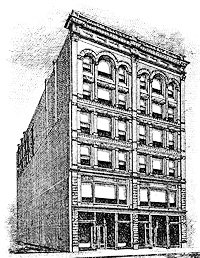 |
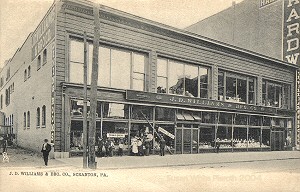 Left: The illustration from an 1897 Foot &
Shear Co. billhead - the Carter & Kennedy building. Click the
image to see the full billhead. From the Scranton Republican,
August 8, 1894, "The contract for the excavation and foundation walls
of the proposed Kennedy & Carter building on Washington avenue
was
yesterday awarded to E. S. Williams." Left: The illustration from an 1897 Foot &
Shear Co. billhead - the Carter & Kennedy building. Click the
image to see the full billhead. From the Scranton Republican,
August 8, 1894, "The contract for the excavation and foundation walls
of the proposed Kennedy & Carter building on Washington avenue
was
yesterday awarded to E. S. Williams."
Click
here for a page showing a Foote & Shear
promotional booklet.
Right: A postcard of the J. D. Williams &
Bro.Co. store published about 1905 by Raphael Tuck &
Sons,
"Scranton,
Pa." Signs in the windows advertise Tennis Goods, House Furnishings,
Baby
Carriages,
and a "Rousing Tin Ware Sale." By 1908 they were again advertising
in the Poli's Theatre Programme.
|
Scranton Times,
Saturday, November 10, 1906
HALF
MILLION DOLLAR FIRE DESTROYED TWO
BUILDINGS; TWELVE FIREMEN INJURED
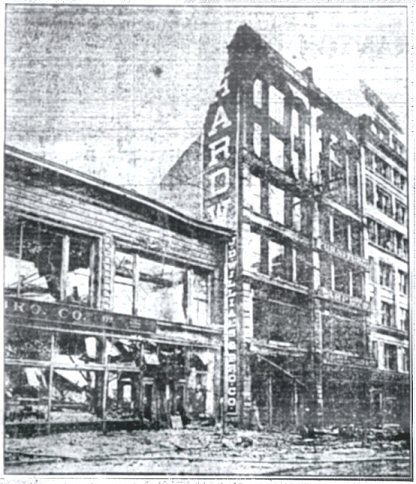 BLOCK WAS ENDANGERED
___________
Carter & Kennedy Building Occupied
by Foote & Shear
and J. Scott Inglis and J. D. Williams & Bro. Co. Building fell
Fury
to the Flames--Insurance One Half of Loss.
BLOCK WAS ENDANGERED
___________
Carter & Kennedy Building Occupied
by Foote & Shear
and J. Scott Inglis and J. D. Williams & Bro. Co. Building fell
Fury
to the Flames--Insurance One Half of Loss.
Fire licked up nearly $550,000 worth of property in the most
valuable
business block in the center city early this morning. It was the worst
conflagration in many years as well as the most spectacular. Starting
at
five minutes past midnight it was 4 o'clock before it was gotten under
control. The ruins are smouldering yet, and half a dozen streams are
playing
on them.
The building of J. D. Williams & Brother company at
111 to 117 Washington
avenue and the Carter and Kennedy building at 119 to 121 adjoining, are
totally destroyed.
Foote & Shear, in whose place the fire was discovered,
occupied
one half of the Carter & Kennedy building, and the furniture
house
of J. Scott Inglis the other half. Both firms were completely wiped out
of stock and fixtures, but the biggest loss is sustained by Williams
Bros.
& Co.
A dozen firemen were hurt, but none seriously. Most of them
were cut
and bruised by flying glass and falling walls and debris.
Charles Lenther, of Engine T, and John Reif, of Hose 6 were
the worst
injured. Lenther had his hand badly cut by flying glass from a big
plate
window. Reif ran a huge splinter in his leg. Both men went to the State
Hospital and after having their wounds bound, pluckily went back to the
fire. Other firemen took such risks in trying to check the progress of
the flames that Superintendent Ferber and Storms had to call them back
several times. Superintendent Ferber himself had a narrow escape from
being
killed by a huge stone that was torn from its place on top of the
Carter
& Kennedy building by a falling cornice. It missed his head by
the
margin of a few inches and shattered itself at his feet.
The injured firemen with few exceptions were treated by Dr. R.
B. White,
who stayed at the scene of the fire with the Hahnemann Hospital
ambulance
until it was under control. The Hahnemann Hospital's ambulance was the
only one on the scene and this morning Superintendent Ferber showed his
appreciation by personally thanking the hospital managers.
Other Buildings Threatened
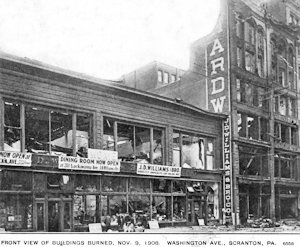 It
was only by an almost superhuman effort that the fire was
confined
to the buildings destroyed. Several times it threatened the Connell
building,
but by a daring exhibition of nerve and intelligence the firemen under
Chief Ferber saved it.
It
was only by an almost superhuman effort that the fire was
confined
to the buildings destroyed. Several times it threatened the Connell
building,
but by a daring exhibition of nerve and intelligence the firemen under
Chief Ferber saved it.
On the Lackawanna avenue side of the burning fire Assistant
Superintendent
Harry Storms with a squad of ten men did heroic work. The blaze here
was
for an hour and a half one of the fieriest spots burning. For the
flames
to have gotten over the low wall of the Williams building would have
meant
destruction at corner and extending down to Jonas Long's Sons store. By
standing on the fall [sic] and on roofs of other places the flames were
kept inside the wall.
A terrific explosion in the basement of Foote & Shear
added to the
danger of the firemen. Two of them were blown clean across the alley in
the rear, while Assistant Storms and one of his men were almost blown
from
a fire escape by the force of the explosion.
Aside from the loss in buildings and stock, 300 men, boys,
women, and
girls employed in Williams' building are temporarily thrown out of
employment.
They will be at work soon, however, as E. B. Williams engaged a small
store
across the street to get things in shape. He announced this morning to
the host of employees, some of them girls in tears, that preparations
are
already under way to start up business for the holidays.
Loss
Over Half Million
The J. D. Williams & Bros. Co. loss is about $230,000.
Of this $120,000
is stock. The total insurance carried is about $205,000.
J. Scott Inglis stated this morning that he, too, would start
as soon
as he could get a new stock. His loss is $125,000, partially covered by
insurance. To a Times reporter he said he was having difficulty in
finding
a place.
Foote & Shear sustained a loss in stock of about
$75,000 on which
a heavy insurance is held.
The Carter & Kennedy building is a six story structure
and valued
at $75,000. The insurance is estimated at $45,000.
The damage to the Connell building is believed will reach
$30,000.
The damage to offices of tenants is estimated at $2,250.
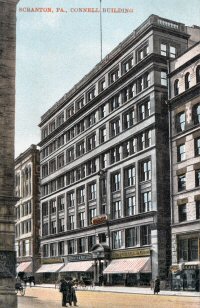
Roofs Caught Fire
Damage was also done to neighboring roofs but the flames from
sparks
were extinguished almost as soon as they broke out and the loss in this
direction is a matter of only a few hundred dollars.
The cellar of Connolly & Wallace is flooded with six
inches of water
[Connolly & Wallace ran an ad in this issue of the paper saying
they
were "untouched" except for the water in the basement] where it came
through
the walls of the burning buildings. A considerable stock is kept in the
basement, but Mr. Connolly stated this morning that until the water was
out it could not be determined what they have suffered.
The total loss so far estimated covers everything except
Connolly &
Wallace, and approximates $537,250. The insurance foots up about
$270,000.
Fire Discovered
It was exactly two minutes after midnight when the fire was
discovered.
Philip Klein, of Klein Bros., the restaurateurs, at the corner of
Duping
court and Spruce street, was closing the place for the night when he
smelled
smoke. He looked down the alley and saw that there was a fire. Hastily
running into the baker of Williams Bros. in the rear, he notified the
baker
on duty and together they made an investigation. Smoke was coming out
of
the cellar of Foote & Shear's. Rushing down the alley they
stumbled
onto Patrolman Thomas Gemmel, who also saw the smoke and was looking
for
the fire, and breathlessly told him the block was afire. Gemmel turned
in an alarm at once from box 231, at the corner of Wyoming avenue and
Spruce
street and then telephoned to police headquarters, Lieutenant Palmer
took
a squad to the scene. Later more police and ropes were sent from
headquarters
and very available man was put on duty keeping the crowd back. In this
direction the cops did great work.
Had Narrow Escapes
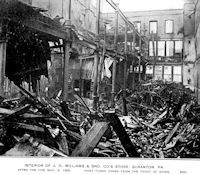 There
was no disorder and the firemen went to work unhampered.
As soon
as Superintendent Ferber got to the fire he directed a chemical line to
the top of the rear of the Foote & Shear building. Assistant
Superintendent
Storms and Link Tillman scrambled up the fire escapes, but a moment
later
it was discovered that the whole interior was already a mass of fire. A
big hose was then ordered turned on. Sims and Shea of the Hook and
Ladder,
were up against the building with the hose in a jiffy, while Chief
Storms
and Tillman were being forced from their post on the fire escape by the
heat, when suddenly there was a terrific roar and a blast of scorching
flame blew up through the building and out the windows. Sims and Shea
were
hurled to the ground and rolled across the alley up against an opposite
wall, while the hose twisted and rolled on the ground like a serpent.
There
was no disorder and the firemen went to work unhampered.
As soon
as Superintendent Ferber got to the fire he directed a chemical line to
the top of the rear of the Foote & Shear building. Assistant
Superintendent
Storms and Link Tillman scrambled up the fire escapes, but a moment
later
it was discovered that the whole interior was already a mass of fire. A
big hose was then ordered turned on. Sims and Shea of the Hook and
Ladder,
were up against the building with the hose in a jiffy, while Chief
Storms
and Tillman were being forced from their post on the fire escape by the
heat, when suddenly there was a terrific roar and a blast of scorching
flame blew up through the building and out the windows. Sims and Shea
were
hurled to the ground and rolled across the alley up against an opposite
wall, while the hose twisted and rolled on the ground like a serpent.
Meanwhile a general alarm was sent in by Chief Ferber and the
entire
fire department responded. Those who answered the first alarm were
battling
valiantly against overwhelming odds until they were reinforced. The
paints
and varnishes and other inflammable material in the Foote &
Shear building
burned like fury and in a remarkably short time the roof went in.
Broke Through Wall
Only a terra cotta wall divided the building from the half
occupied
J. Scott Inglis. This was eaten up like laths and allowed the fire to
move
towards the Connell building. Soon the heavily stocked floors of
furniture
in the J. Scott Inglis side, were alive with fire from the first floor
to the top. Floors fell with crashes that sent myriads of sparks and
burning
wood high in the air, when the wind carried it for blocks away. Other
dropped
on surrounding buildings and placed the whole block in danger for a
time.
Walls Topple Over
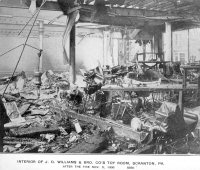 The
Williams building had been practically untouched until then. Firemen
were
put on the roof of the Connell building and tons of water were poured
into
the burning buildings. The regular department was assisted by the
Independent
Hose company, of Dunmore, which of its own accord, brought its
apparatus
all the way into the city and volunteered their services to Chief
Ferber.
It was gladly accepted. Every man was needed; some to relive the men
who
were exhausted and smothered by the dense smoke, and had to be order
out
into the air. Good work was especially done when the flames crept
around
the rear of the big Connell building, into the areaway and into some of
the offices. One of the most desperate fights was made on the sixth,
seventh
and eighth floors, principally the two top floors, all unknown to the
thousands
of spectators that left their couches to see the fire.
The
Williams building had been practically untouched until then. Firemen
were
put on the roof of the Connell building and tons of water were poured
into
the burning buildings. The regular department was assisted by the
Independent
Hose company, of Dunmore, which of its own accord, brought its
apparatus
all the way into the city and volunteered their services to Chief
Ferber.
It was gladly accepted. Every man was needed; some to relive the men
who
were exhausted and smothered by the dense smoke, and had to be order
out
into the air. Good work was especially done when the flames crept
around
the rear of the big Connell building, into the areaway and into some of
the offices. One of the most desperate fights was made on the sixth,
seventh
and eighth floors, principally the two top floors, all unknown to the
thousands
of spectators that left their couches to see the fire.
At 1 o'clock the walls of the Foote & Shear building
fell, just
as the firemen dreaded, on to the roof of the Williams building, which
was three stories lower than the Foote & Shear building. The
heavy
brick walls on the south brought with it tons and tons of iron, planks
and bricks. It all crashed through the Williams building and piled up
in
the northeast corner. Had it not been for this the Williams building
would
have been saved as the firemen were doing great work, but with the
falling
of the walls the flames spread to the rear and the bakery and
storehouse
containing sugar and other inflammable stuff caught fire.
Horses Taken Out
Liverymen took their horses and vehicles out and lined them
along Spruce
street, early in the progress of the fire.
Once when the firemen got working with their combined streams
it looked
as though the fire in the rear was under control, but it was only
laying
low as it were, for without warning a burst of flame, that curled and
twisted
itself into fantastic and weird shapes on the sky above, shot high in
the
air. The wood work crackled and sparks swept through the air onto the
crowd
below as if from a volcano. The cops pushed the crowd that jammed the
street
back out of danger and the firemen went to work with renewed energy.
The pile of debris, twisted iron and burning timber, in the
corner on
the first floor of the Williams building, where the wall had crashed
through,
blazed up with increasing fury, while the rear fire kept creeping up
towards
the front, along the south end of the store. It was only burning the
roof
in the front of the building and strenuous efforts were made to nip it,
but it was only a matter of half an hour when the blaze came through
the
first floor and up through the roof went flames that circled a hundred
feet in the air.
Fighting the Flames
Three brave fellows stood on the wall silhouetted against a
background
of fire with a hose. There was no room for more, and with the dense
smoke
blinding and choking them, they fought desperately to keep back the
flames.
One relieved the other as the smoke become thicker. The crowd watched
with
bated breath as the flames crept nearer and the men edged back. How
they
stood it is beyond conception, but they held their ground for an hour,
not moving as much as a foot. Below them the first and second floors
were
a red, angry mass, eating up like a hungry monster the frail toys and
furnishings
in the store. When it seemed as though the flame would leap the wall
and
spread to the places on Lackawanna avenue whose rear faced the burning
Williams building, a white-coated figure, followed by half a dozen men
in wet black coats and dripping red helmets made its appearance. It was
Storms at the head of his men with a mighty stream. Crash into a window
went the water, up went a whirl of flame and smoke greater than before,
as if in mockery. So it kept on, Storms on the side and Ferber around
front
fighting the fire on the first floor, going right inside with the
flames
leaping all around.
Ceaseless Battling
| An hour and a half it kept up, the
ceaseless battling with
the raging fire, every man doing his utmost and more than nature ever
intended
him to do, all this without exaggeration, for never in the history of
the
fire department did men fight more grandly. They went right into the
burning
pile and with hooks tore down hundreds of feet of sheet metal ceiling
which
prevented them from getting at the burning roof from the street with
their
streams. The crowd watched all with a peculiar silence. Now it looked
as
though the fire was subdued and under control when it would only
rekindle
with greater strength in another part. Several times, too, the firemen
in the street were forced to go back to the Foote & Shear
building
and the force up in the Connell building were called upon to keep back
the flames a they swept up whenever a roof or part of a wall would
fall.
It was a spectacular sight and the heavens were lit for miles around.
Director of Public Safety F. L. Wormser and
Superintendent of the Bureau
of Buildings F. L. Brown were on the scene early and helped direct the
work of the firemen.
Finally at four o'clock the fire was under control and
Chief Ferber
began sending some of the fire companies home. Not until then did
Director
Wormser leave the scene. Chief Ferber and assistant, Superintendent
Storms,
stayed on duty all night and were on duty this morning. Hot coffee was
served to the firemen.
|
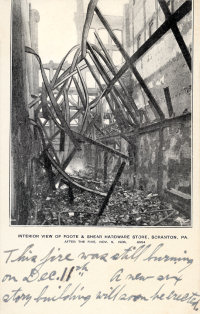
Foote & Shear Hardware Store. "This fire was still burning on
Dec.
11th. A new six story building will soon be erected." |
Firemen Blinded
James Connell told Chief Ferber during the fire to let his men
have
all the coffee and sandwiches they wanted at his expense.
Once when the fire was extremely hot William Reilly of Hose 5
was blinded
by the heat, and on the verge of staggering into a dangerous part of
the
building when the quick eye of Chief Ferber caught him. "Come out of
their
Reilly," he ordered. "Take him down to Thompson's Hospital," to
another,
and Reilly was taken down to the hospital to have his eyes fixed up. He
came back later and went to work again.
Upon the eighth floor of the Connell building the flames did
$800 worth
of damage to the Fire Insurance Underwriters offices; $400 damage to
the
office of the International Salt company; on the seventh floor Attorney
Jos. F. Gilroy suffered $100 in damages, the Board of Control $800.
Secretary
Fellows' books and papers in his desk were soaked with water. Other
property
? was damaged by the same force. G. N. Edson, the architect, reported
damage
of about $50, and W. S. McMillan 200 to optical instruments.
All the awnings in the areaway and in the rear of the building
and the
window casings were burned.
During the fire Chief Ferber kept a couple of hose carts in
the west
end and in the upper end of the city in case of emergency.
Poor Fire Wall
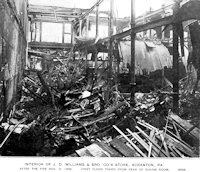 Building
Superintendent Brown was on the ground this morning
again with
Director of Public Works Charles Acker. With Superintendent Ferber they
made an examination of the burned buildings. Chief Ferber stated that
had
it not been for the fact that the "wall" between the Foote &
Shear
building and the J. Scott Inglis building was only terra cota and
practically
nothing more than a thin partition the fire would not have touched the
Inglis store. Superintendent Brown also spoke of the poor partition.
Building
Superintendent Brown was on the ground this morning
again with
Director of Public Works Charles Acker. With Superintendent Ferber they
made an examination of the burned buildings. Chief Ferber stated that
had
it not been for the fact that the "wall" between the Foote &
Shear
building and the J. Scott Inglis building was only terra cota and
practically
nothing more than a thin partition the fire would not have touched the
Inglis store. Superintendent Brown also spoke of the poor partition.
Insurance underwriters and experts who inspected the burned
buildings
this morning were loud in their praise of the manner in which the fire
was handled. The burned area is in what the insurance trust termed the
"conflagration district" some time ago, and it was the opinion of local
insurance men that the fire here would give their to have the rates
reduced
a black eye. But they were more than pleased at the way the fire was
kept
from going down Lackawanna avenue.
Clouds of Steam
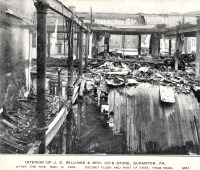 The heavy iron girders in the Williams
building stood a severe test.
It is believed there will be some salvage in the building when the
smouldering
in the ruins is extinguished. Big clouds of steam and smoke are arising
from the blackened and charred mass and only the walls of the Carter
and
Kennedy building are standing. They will probably have to come down.
The
work of saving what is left in the front of the Williams building is
already
under way. With an inspiring courage despite their great loss, E. B.
Williams
said this morning: "It is a great blow, but we will be in the ring for
the holidays. We are getting ready to resume business now."
The heavy iron girders in the Williams
building stood a severe test.
It is believed there will be some salvage in the building when the
smouldering
in the ruins is extinguished. Big clouds of steam and smoke are arising
from the blackened and charred mass and only the walls of the Carter
and
Kennedy building are standing. They will probably have to come down.
The
work of saving what is left in the front of the Williams building is
already
under way. With an inspiring courage despite their great loss, E. B.
Williams
said this morning: "It is a great blow, but we will be in the ring for
the holidays. We are getting ready to resume business now."
The Commonwealth building, down on the corner, nearly a block
away,
was in danger. Fire was discovered in the headhouse, over the elevator
shaft and was making headway when it was attacked and put out.
Megargee's paper warehouse, directly in the rear of the
burning building
was in the danger zone and a large quantity of paper was damaged by
water.
Carter
& Kennedy Will Rebuild on Site of Fire Ruins
The Scranton
Times, November 16, 1906.
As
soon as the walls of the Carter & Kennedy building are torn
down
and the insurance adjusters finish their work the owners will ...
contract for the construction of a handsome new building on the same
site. It will be no smaller than the one destroyed and will likely be
much taller, to conform with the proposed new Williams building and the
Connell building on either side.
When seen by a Times reporter
this morning Mr. Kennedy said that he and Mr. Carter would consult with
the Foote & Shear company and J. Scott Inglis, their former
tenants, before starting work on their new building with a view toward
following out their suggestions in case they care to renew their
leases.
These
firms will be given first call on the stores, which will rank among the
largest and finest in the city and it is likely that the whold building
will be occupied by them as formerly. No plans have been maded for
office rooms or the upper floors. [For a larger version of the first
postcard shown above, click here.]
By Susan Carter
White Pieroth. Special thanks to Norma Reese for
finding these
articles and sending the copies.
The text and images on this page may by
saved for personal
research, but may not be published in any form, including copied to
another
web site, without specific
permission. Copyright
2004-2013
Return to the Carter
and Kennedy Main
Page

 Left: The illustration from an 1897 Foot &
Shear Co. billhead - the Carter & Kennedy building. Click the
image to see the full billhead. From the Scranton Republican,
August 8, 1894, "The contract for the excavation and foundation walls
of the proposed Kennedy & Carter building on Washington avenue
was
yesterday awarded to E. S. Williams."
Left: The illustration from an 1897 Foot &
Shear Co. billhead - the Carter & Kennedy building. Click the
image to see the full billhead. From the Scranton Republican,
August 8, 1894, "The contract for the excavation and foundation walls
of the proposed Kennedy & Carter building on Washington avenue
was
yesterday awarded to E. S. Williams." BLOCK WAS ENDANGERED
BLOCK WAS ENDANGERED






